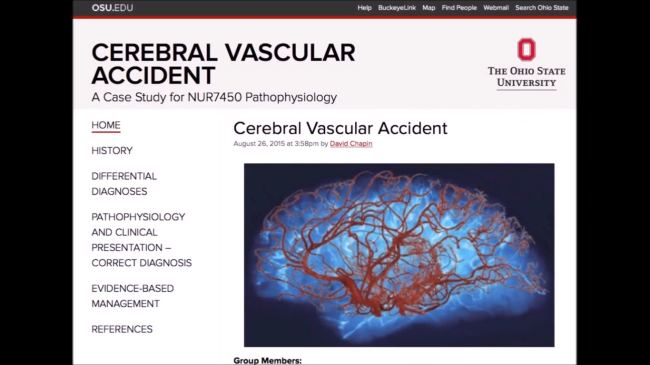You have /5 articles left.
Sign up for a free account or log in.

A case study from Ohio State's pathophysiology course
Radiological Image, by Marinković et al. (2010).
In this new feature, we're trying to create a space to discuss institutional experiments with digital technologies -- what worked, what didn't, and what other colleges can learn from the attempts. (The Online Learning Consortium's Effective Practices program has contributed initial ideas.) Send your nominations for future columns to digital.learning@insidehighered.com.
***
Institution: Ohio State University
The Problem: As with many large core classes (especially in practical fields), Ohio State’s pathophysiology course for advanced practice nursing students requires students to absorb a ton of information and learn to apply it in real-world settings (to “bridge the knowledge-practice gap,” in the parlance of the field). Requiring students to work through case studies is a much better way to get them to apply knowledge than multiple-choice assessments are -- but in a course that nearly doubled in size to more than 200 students, in-person and online, instructors struggled to develop case studies on enough topics and to engage students sufficiently deeply in the work.
The Goal: Inject digital case studies into the curriculum in ways that made students creators rather than just absorbers of knowledge. “This material can be very dry, and after a while, you can be the best lecturer and still not be able to retain students’ interest,” says Jodi McDaniel, associate professor of nursing and the pathophysiology instructor.
The Experiment: McDaniel took a first stab at introducing case studies in 2014, when she and a course associate created a handful of case studies in Softchalk and had groups of students analyze them to diagnose the “patients,” prepare annotated bibliographies about the conditions, and the like.
In 2015, the instructional designer, Joni Tornwall, suggested to McDaniel that they respond to the isolation that set in as class size grew (to 230) by having groups of students develop their own studies. “We had these great case studies, but we needed more, so we thought we’d turn the students into creators rather than consumers,” Tornwall says. “Having them do more of the work means they learn more and we put less strain on the instructors.”
Students divided into groups by using Google Docs to choose from a series of what McDaniel described as “common diseases they would normally see in the field.” Using the instructor-created studies as models, the students created and presented their own case studies in the course blog on Wordpress, incorporated feedback that fellow students offered on their presentations into the case studies, and then submitted final versions at the end of the semester. Students in the online sections of the course created their presentations digitally in Voicethread rather than presenting in class.
What Worked (and Why): The process forced students to think about the content in an entirely different way. For instance, in analyzing an existing case study, a nursing student might look at the symptoms and figure out which three diagnoses might make sense, and then which is likeliest. Creating their own case studies (and making up the patients out of whole cloth) instead forced students to “be more creative to work backwards to come up with what other diagnoses would have to be ruled out” to come up with the chosen diagnosis, one student explained in her course review.
What Didn’t (and Why): With roughly 50 case studies, grading was a challenge for the instructors, who tried to limit that burden by letting students peer review each others’ studies after they were presented. But McDaniel says that the way they designed the peer component made it difficult to assess students’ contributions to the peer review process.
Next Steps: Enrollment in the course ballooned to nearly 260 last fall, and the instructors dropped the case study element because they feared it would be unmanageable at that size, replacing them with more multiple-choice quizzes. Students didn’t like the change, saying the quizzes helped them learn, but not apply, the material. “Now we have the evidence that we really need to bring [the case studies] back,” said Tornwall.
The course will be offered again next fall, and the instructors are planning a series of changes to improve the course’s delivery. Ohio State’s new Canvas learning management system includes an automated peer review system that the instructors hope will ease the grading burden. And all students are expected to do their presentations online, rather than in-class. “The virtual presentations through Voicethread," Tornwall says, "are far more engaging than listening to somebody read a Powerpoint."








